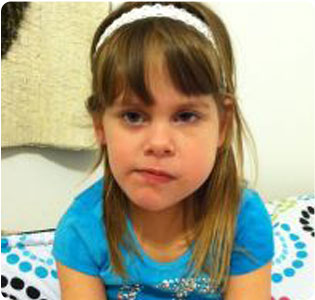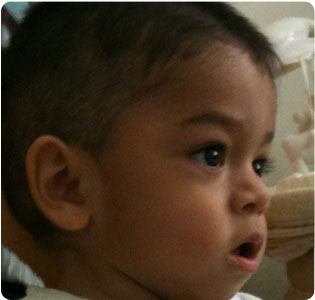ABOUT THE DISEASE
What is CLOVES?
CLOVES is an extremely rare progressive overgrowth disorder, affecting less than 3oo people worldwide. The symptoms vary from mild soft-tissue tumors to Vascular Malformations encompassing the spine or internal organs. Many patients diagnosed with CLOVES have a large sandal gap. Patients do not have to exhibit every symptom in the list below; we often find that patients have a combination of these symptoms.
CLOVES stands for Congenital, Lipomatous, Overgrowth, Vascular Malformations, Epidermal Nevi, Spinal/ Skeletal Anomalies or Scoliosis.
- C is for congenital, this is something existing at birth and often before birth, or that develops during the first month of life, regardless of causation.
- L is for lipomatous which means pertaining to or resembling a benign tumor made up of mature fat cells. Most Cloves patients present with a soft fatty mass at birth, often visible on one or both sides of the back, legs and/or abdomen.
- O is for overgrowth which means there is an abnormal increase in the size of the body or a body part that is often noted at birth. Patients with Cloves, may have affected areas of their bodies that grow at a faster rate than other people. Overgrowth of extremities (usually arms or legs) is seen with, large wide hands or feet, large fingers or toes, wide space between fingers and asymmetry of body parts.
- V is for Vascular Malformations, which is a term used to refer to blood vessel abnormalities. Patients with Cloves have different venous, capillary, and lymphatic pathways - typically capillary, venous and lymphatic malformations are known as "slow flow" lesions. Some patients with Cloves have combined lesions (which are fast flow) and some have extremely rare and aggressive vascular malformation known as Arterio-Venous Malformation (AVM). The effect of a Vascular Malformation varies per patient based on the type, size, and location of the malformation, and symptoms can vary.
- E is for Epidermal Nevi which is the medical term for sharply-circumscribed and chronic lesions of the skin and benign by definition. These are often flesh-colored, raised or warty.
- S is for Spinal/Skeletal Anomalies, and/or Scoliosis. Some patients with CLOVES have tethered spinal cord, vascular malformations in or around their spines or other spinal abnormalities. High flow, aggressive spinal lesions (like AVM) can cause serious neurological deficits/paralysis.
There are a variety of signs and symptoms not covered in the CLOVES acronym - they include reddish/pinkish birthmark or port wine stain, a sandal gap in one or both feet, other skin abnormalities include prominent veins, and lymphatic vesicles (similar to blisters). Some patients with CLOVES have orthopedic challenges related to knees, feet, or hips, and may have different sized kidneys or even have an absent kidney. Wilms Tumor (childhood kidney cancer) is more common with Overgrowth disorders, so your doctor should recommend quarterly ultrasounds to monitor kidney abnormalities.
We want to offer a special thank you to Kristen Davis for defining Cloves Syndrome.












